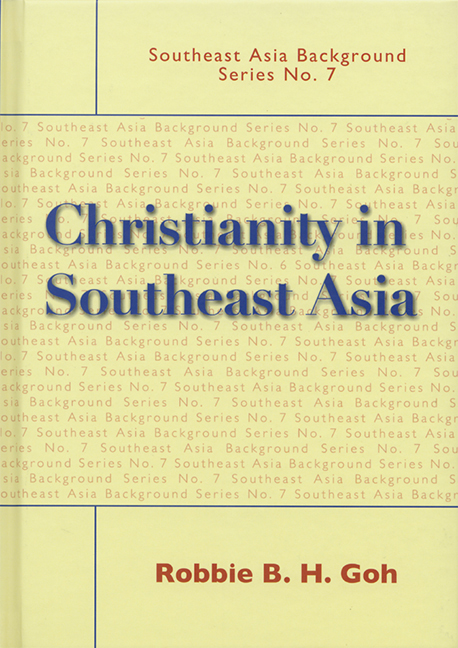Book contents
- Frontmatter
- Contents
- About the Author
- 1 Introduction: Missionary Movements and the Coming of Christianity to Southeast Asia
- 2 The Philippines
- 3 Singapore
- 4 Malaysia
- 5 Indonesia
- 6 Christianity in the Other Countries of Southeast Asia: Brunei, Myanmar, Thailand, Cambodia, Laos and Vietnam
- 7 Christianity in the Other Countries of Southeast Asia: Brunei, Myanmar, Thailand, Cambodia, Laos and Vietnam
- References
6 - Christianity in the Other Countries of Southeast Asia: Brunei, Myanmar, Thailand, Cambodia, Laos and Vietnam
Published online by Cambridge University Press: 21 October 2015
- Frontmatter
- Contents
- About the Author
- 1 Introduction: Missionary Movements and the Coming of Christianity to Southeast Asia
- 2 The Philippines
- 3 Singapore
- 4 Malaysia
- 5 Indonesia
- 6 Christianity in the Other Countries of Southeast Asia: Brunei, Myanmar, Thailand, Cambodia, Laos and Vietnam
- 7 Christianity in the Other Countries of Southeast Asia: Brunei, Myanmar, Thailand, Cambodia, Laos and Vietnam
- References
Summary
Although Christianity for various reasons has developed less significantly in the other countries in Southeast Asia, in many cases there have been instances of local impact; furthermore, even in countries where Christianity has not become a major religion, its interaction with the other religions and with governance has interest for an understanding of the region as a whole.
Of the other six countries in Southeast Asia, the two countries in which Christianity has made the largest impact are the former British colony and protectorate (respectively) of Myanmar and Brunei. This would once again reinforce the notion that the British colonial government played a significant role in the spread of Christianity in the region, if not in any overt attempt to propagate the religion, at least in the general sense of maintaining the rule of law conducive for missionary movements and activities, and in its tolerance of missionary efforts particularly in areas like education and social welfare. British policies to encourage trade and to bring in immigrant labour also had an impact on Christianity, since in many cases this resulted in a more mixed population that qualified the religious-cultural dominant, and created opportunities for missionaries to spread the Christian faith to some sectors of the populace.
Myanmar
The British annexed Myanmar progressively via a series of treaties from 1826 to 1886, and governed it as a province of India for most of its colonial history, chiefly to prevent the warlike tribes in Burma (as it was then known) from disrupting British commercial activities in eastern India, but also to exploit Burma's valuable natural resources such as teakwood. The Portuguese had introduced Catholicism to Burma in the sixteenth century, but this did not have a significant impact as the Portuguese did not establish any territorial control. However, Burma's proximity to India also made it a logical extension to missionary endeavours in India, and from early in the nineteenth century, missionaries involved in India were already planning to cross over into the new mission field of Burma.
- Type
- Chapter
- Information
- Christianity in Southeast Asia , pp. 65 - 72Publisher: ISEAS–Yusof Ishak InstitutePrint publication year: 2005



